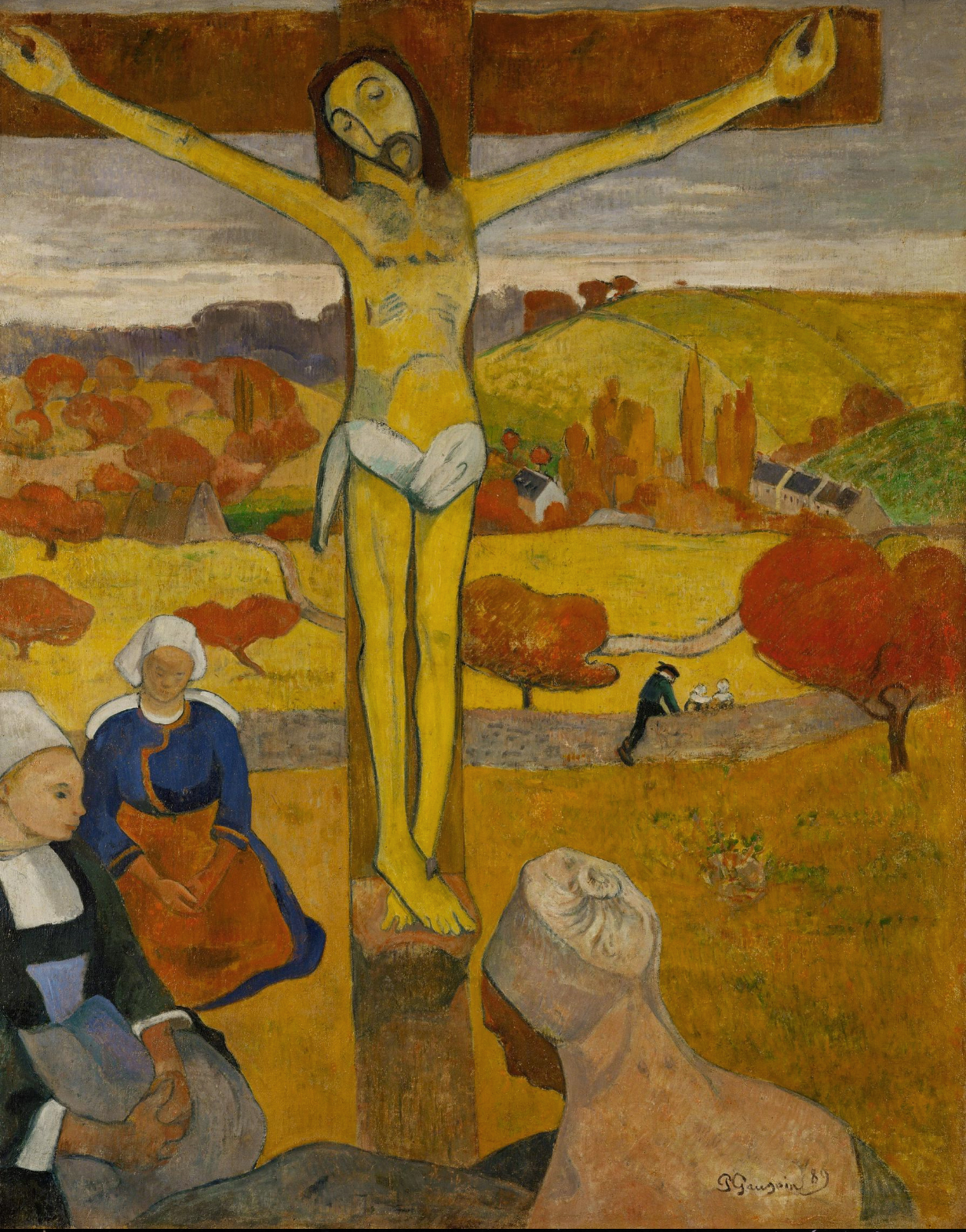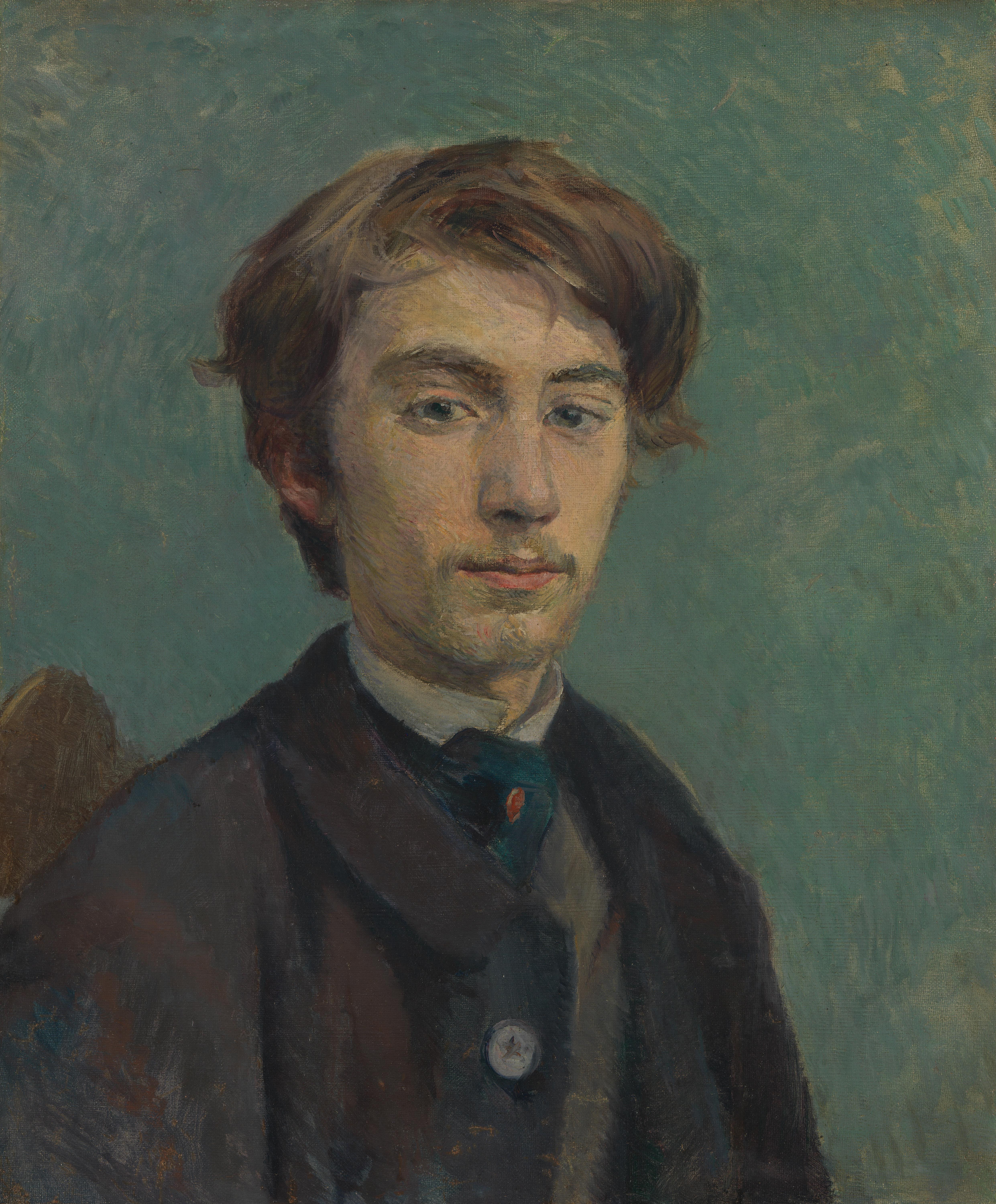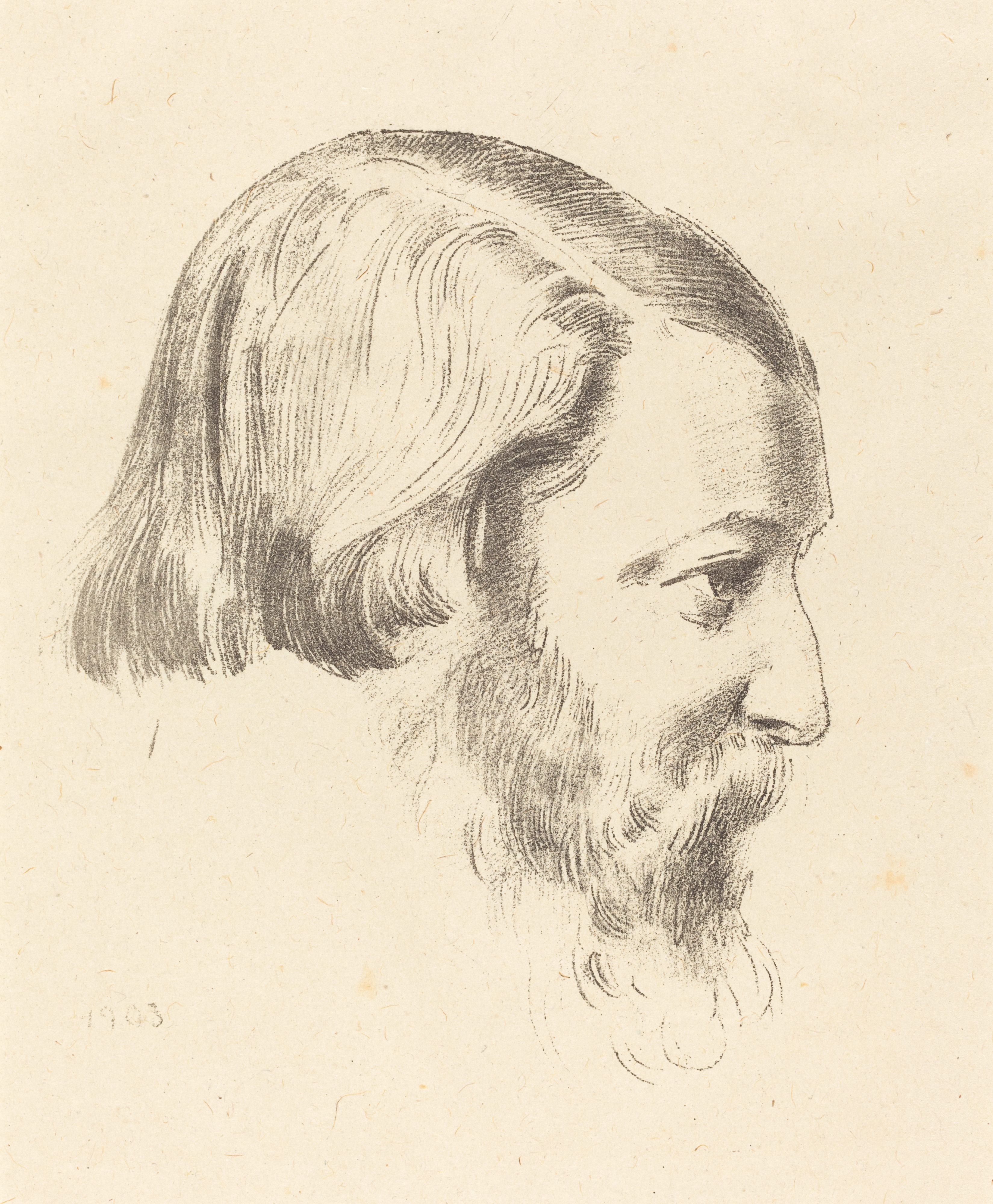|
Cloisonnism
Cloisonnism is a style of post-Impressionist painting with bold and flat forms separated by dark contours. The term was coined by critic Édouard Dujardin on the occasion of the Salon des Indépendants, in March 1888. Artists Émile Bernard, Louis Anquetin, Paul Gauguin, Paul Sérusier, and others started painting in this style in the late 19th century. The name evokes the technique of '' cloisonné'', where wires (''cloisons'' or "compartments") are soldered to the body of the piece, filled with powdered glass, and then fired. Many of the same painters also described their works as Synthetism, a closely related movement. In '' The Yellow Christ'' (1889), often cited as a quintessential cloisonnist work, Gauguin reduced the image to areas of single colors separated by heavy black outlines. In such works he paid little attention to classical perspective and eliminated subtle gradations of color—two of the most characteristic principles of post-Renaissance painting. The c ... [...More Info...] [...Related Items...] OR: [Wikipedia] [Google] [Baidu] |
Gauguin Il Cristo Giallo
Eugène Henri Paul Gauguin (, ; ; 7 June 1848 – 8 May 1903) was a French Post-Impressionist artist. Unappreciated until after his death, Gauguin is now recognized for his experimental use of colour and Synthetist style that were distinct from Impressionism. Toward the end of his life, he spent ten years in French Polynesia. The paintings from this time depict people or landscapes from that region. His work was influential on the French avant-garde and many modern artists, such as Pablo Picasso and Henri Matisse, and he is well known for his relationship with Vincent and Theo van Gogh. Gauguin's art became popular after his death, partially from the efforts of dealer Ambroise Vollard, who organized exhibitions of his work late in his career and assisted in organizing two important posthumous exhibitions in Paris. Gauguin was an important figure in the Symbolist movement as a painter, sculptor, printmaker, ceramist, and writer. His expression of the inherent meaning of ... [...More Info...] [...Related Items...] OR: [Wikipedia] [Google] [Baidu] |
Post-Impressionism
Post-Impressionism (also spelled Postimpressionism) was a predominantly French art movement that developed roughly between 1886 and 1905, from the last Impressionist exhibition to the birth of Fauvism. Post-Impressionism emerged as a reaction against Impressionists' concern for the naturalistic depiction of light and colour. Its broad emphasis on abstract qualities or symbolic content means Post-Impressionism encompasses Les Nabis, Neo-Impressionism, Symbolism, Cloisonnism, the Pont-Aven School, and Synthetism, along with some later Impressionists' work. The movement's principal artists were Paul Cézanne (known as the father of Post-Impressionism), Paul Gauguin, Vincent van Gogh and Georges Seurat. The term Post-Impressionism was first used by art critic Roger Fry in 1906.Peter Morrin, Judith Zilczer, William C. Agee, ''The Advent of Modernism. Post-Impressionism and North American Art, 1900-1918'', High Museum of Art, 1986 Critic Frank Rutter in a review of the Salon d'A ... [...More Info...] [...Related Items...] OR: [Wikipedia] [Google] [Baidu] |
Émile Bernard (painter)
Émile Henri Bernard (28 April 1868 – 16 April 1941) was a French Post-Impressionist painter and writer, who had artistic friendships with Vincent van Gogh, Paul Gauguin and Eugène Boch, and at a later time, Paul Cézanne. Most of his notable work was accomplished at a young age, in the years 1886 through 1897. He is also associated with Cloisonnism and Synthetism, two late 19th-century art movements. Less known is Bernard's literary work, comprising plays, poetry, and art criticism as well as art historical statements that contain first-hand information on the crucial period of modern art to which Bernard had contributed. Biography Émile Henri Bernard was born in Lille, France, in 1868. As in his younger years his sister was sick, Émile was unable to receive much attention from his parents; he therefore stayed with his grandmother, who owned a laundry in Lille, employing more than twenty people. She was one of the greatest supporters of his art. The family moved to ... [...More Info...] [...Related Items...] OR: [Wikipedia] [Google] [Baidu] |
Paul Gauguin
Eugène Henri Paul Gauguin (, ; ; 7 June 1848 – 8 May 1903) was a French Post-Impressionist artist. Unappreciated until after his death, Gauguin is now recognized for his experimental use of colour and Synthetist style that were distinct from Impressionism. Toward the end of his life, he spent ten years in French Polynesia. The paintings from this time depict people or landscapes from that region. His work was influential on the French avant-garde and many modern artists, such as Pablo Picasso and Henri Matisse, and he is well known for his relationship with Vincent and Theo van Gogh. Gauguin's art became popular after his death, partially from the efforts of dealer Ambroise Vollard, who organized exhibitions of his work late in his career and assisted in organizing two important posthumous exhibitions in Paris. Gauguin was an important figure in the Symbolist movement as a painter, sculptor, printmaker, ceramist, and writer. His expression of the inherent meaning of ... [...More Info...] [...Related Items...] OR: [Wikipedia] [Google] [Baidu] |
Post-Impressionism
Post-Impressionism (also spelled Postimpressionism) was a predominantly French art movement that developed roughly between 1886 and 1905, from the last Impressionist exhibition to the birth of Fauvism. Post-Impressionism emerged as a reaction against Impressionists' concern for the naturalistic depiction of light and colour. Its broad emphasis on abstract qualities or symbolic content means Post-Impressionism encompasses Les Nabis, Neo-Impressionism, Symbolism, Cloisonnism, the Pont-Aven School, and Synthetism, along with some later Impressionists' work. The movement's principal artists were Paul Cézanne (known as the father of Post-Impressionism), Paul Gauguin, Vincent van Gogh and Georges Seurat. The term Post-Impressionism was first used by art critic Roger Fry in 1906.Peter Morrin, Judith Zilczer, William C. Agee, ''The Advent of Modernism. Post-Impressionism and North American Art, 1900-1918'', High Museum of Art, 1986 Critic Frank Rutter in a review of the Salon d'A ... [...More Info...] [...Related Items...] OR: [Wikipedia] [Google] [Baidu] |
Paul Sérusier
Paul Sérusier (9 November 1864 – 7 October 1927) was a French painter who was a pioneer of abstract art and an inspiration for the avant-garde Nabis movement, Synthetism and Cloisonnism. Education Sérusier was born in Paris. He studied at the Académie Julian and was a monitor there in the mid-1880s. In the summer of 1888 he travelled to Pont-Aven and joined the small group of artists centered there around Paul Gauguin. While at the Pont-Aven artist's colony he painted a picture that became known as '' The Talisman'', under the close supervision of Gauguin. The picture was an extreme exercise in Cloisonnism that approximated to pure abstraction. He was a Post-Impressionist painter, a part of the group of painters called Les Nabis. Sérusier, along with Paul Gauguin, named the group. Pierre Bonnard, Édouard Vuillard and Maurice Denis became the best known of the group, but at the time they were somewhat peripheral to the core group. In 1892 Sérusier met and befrien ... [...More Info...] [...Related Items...] OR: [Wikipedia] [Google] [Baidu] |
Émile Bernard Chronology
This is an Émile Bernard chronology of the life and career of French artist, art critic and writer Émile Bernard, based on documents hitherto published - however, most of the relevant sources remain unpublished. To a certain extent, these gaps can be filled by information derived from letters and biographies of e.g. Vincent van Gogh, Paul Gauguin and Émile Schuffenecker. Bernard and his work is associated with Post-Impressionism, Cloisonnism and Synthetism. : 1860s 1870s 1880s 1890s 1900s 1910s 1920s 1930s 1940s ''The Vanguard Years:'' 1884 1886 1887 1888 1889 1890 1891 1892 1893 1894 1895 1896 1897 __NOTOC__ 1860s *1868, April 26: born in Lille, to an employee of the textile industry 1870s *1870: Due to the Franco Prussian War, the family moved to St. Aignan (near Rouen) *1871, February 14: Birth of his sister Madeleine *1876: The family moved to Loos (near Lille) and prospered economically. *1877: Émile attended Collège de la Monnaie at Lille whilst staying with his mate ... [...More Info...] [...Related Items...] OR: [Wikipedia] [Google] [Baidu] |
Louis Anquetin
Louis Émile Anquetin (26 January 1861 – 19 August 1932) was a French painter. Biography Anquetin was born in Étrépagny, France, and educated at the Lycée Pierre Corneille in Rouen. In 1882 he came to Paris and began studying art at Léon Bonnat's studio, where he met Henri de Toulouse-Lautrec. The two artists later moved to the studio of Fernand Cormon, where they befriended Émile Bernard and Vincent van Gogh. Around 1887, Anquetin and Bernard developed a painting style that used flat regions of color and thick, black contour outlines. This style, named ''cloisonnism'' by critic Édouard Dujardin, was inspired by both stained glass and Japanese ukiyo-e. One example of this can be seen in ''Avenue de Clichy: Five O’Clock in the Evening'', argued by Dr. Bogomila Welsh-Ovcharov as being inspiration for Van Gogh's famous ''Cafe Terrace at Night''.Welsh-Ovcharov, Bogomila: ''Vincent van Gogh and the Birth of Cloisonism'' (!), Art Gallery of Ontario, Toronto, 24 January ... [...More Info...] [...Related Items...] OR: [Wikipedia] [Google] [Baidu] |
Synthetism
Synthetism is a term used by post-Impressionist artists like Paul Gauguin, Émile Bernard and Louis Anquetin to distinguish their work from Impressionism. Earlier, ''Synthetism'' has been connected to the term Cloisonnism, and later to Symbolism. The term is derived from the French verb ''synthétiser'' (''to synthesize'' or ''to combine so as to form a new, complex product''). History Paul Gauguin, Émile Bernard, Louis Anquetin, and others pioneered the style during the late 1880s and early 1890s. Synthetist artists aimed to ''synthesize'' three features: *The outward appearance of natural forms. *The artist's feelings about their subject. *The purity of the aesthetic considerations of line, colour and form. In 1890, Maurice Denis summarized the goals for synthetism as, :''It is well to remember that a picture before being a battle horse, a nude woman, or some anecdote, is essentially a flat surface covered with colours assembled in a certain order.'' The term was first used ... [...More Info...] [...Related Items...] OR: [Wikipedia] [Google] [Baidu] |
The First Moderns
''The First Moderns: Profiles in the Origins of Twentieth-Century Thought'' is a book on Modernism by historian William Everdell, published in 1997 by the University of Chicago Press. A ''New York Times'' Notable Book of 1997, and included by the New York Public Library on its list of "25 Books to Remember from 1997," ''The First Moderns'' suggests that "the heart of Modernism is the postulate of ontological discontinuity." Background and overview Everdell, Dean of Humanities at Saint Ann's School (Brooklyn), Saint Ann's School in Brooklyn Heights, posits that Modernism first emerged in the field of mathematics rather than the arts, specifically in the work of German mathematician Richard Dedekind, who, in 1872, demonstrated that mathematicians operate without a continuum; this represents the formalization of Everdell's axiom of "ontological discontinuity," which he goes on to examine in a multiplicity of contexts. He examines this emerging framework of discreteness in science (L ... [...More Info...] [...Related Items...] OR: [Wikipedia] [Google] [Baidu] |
The Volpini Exhibition, 1889
The Volpini Exhibition was an exhibition of paintings arranged by Paul Gauguin and his circle held at the Café des Arts on the Champ de Mars, not far from the official art pavilion of the 1889 '' Exposition universelle'' in Paris. Lucie-Smith, Edward (1972). ''Symbolist Art''. London: Thames & Hudson, p. 94. A poster and an illustrated catalogue were printed, but the show of "Paintings by the Impressionist and Synthetist Group", held in June and early July 1889, was ignored by the press and proved to be a failure. Background The official art exhibition at the Académie des Beaux-Arts accompanying the ''Exposition universelle'' displayed works by invited artists only, and the selection of works to be exhibited had to pass the judgement of official juries. Neither Gauguin nor his friends could hope to enter this exhibition. However, by chance Emile Schuffenecker found another way that they might present their work to the public in conjunction with the exposition. Monsieur Volpini ... [...More Info...] [...Related Items...] OR: [Wikipedia] [Google] [Baidu] |
Paris
Paris () is the Capital city, capital and List of communes in France with over 20,000 inhabitants, most populous city of France, with an estimated population of 2,165,423 residents in 2019 in an area of more than 105 km² (41 sq mi), making it the List of cities proper by population density, 30th most densely populated city in the world in 2020. Since the 17th century, Paris has been one of the world's major centres of finance, diplomacy, commerce, Fashion capital, fashion, gastronomy, and science. For its leading role in the arts and sciences, as well as its very early system of street lighting, in the 19th century it became known as "the City of Light". Like London, prior to the Second World War, it was also sometimes called Caput Mundi#Paris, the capital of the world. The City of Paris is the centre of the Île-de-France Regions of France, region, or Paris Region, with an estimated population of 12,262,544 in 2019, or about 19% of the population of France, making the ... [...More Info...] [...Related Items...] OR: [Wikipedia] [Google] [Baidu] |







